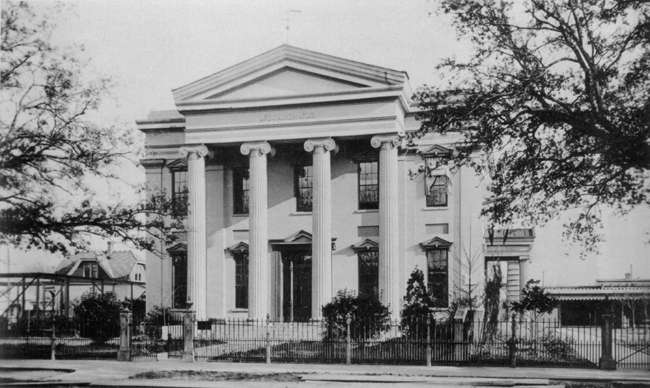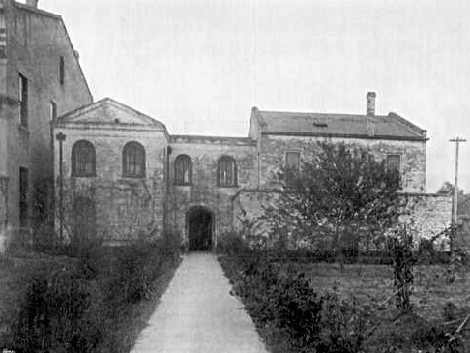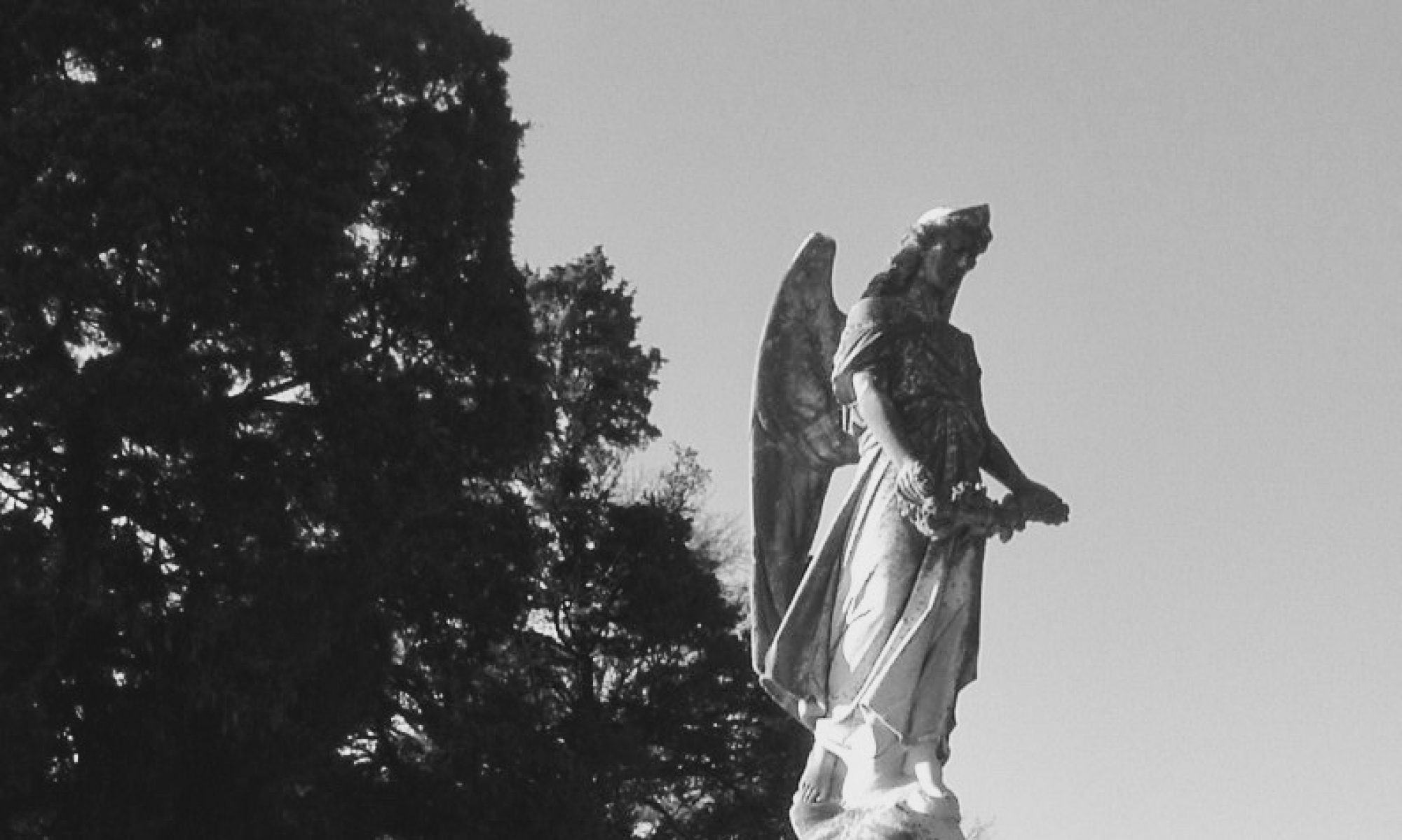…for I doubt if there is another building in the while South that has been the theatre of more mental travail. Do you remember Hugo’s ‘Last Days of a Condemned Man?’ That horrible drama has been enacted over and over again inside its walls. And think of the desperate men who have taken their lives in its cells, and the other desperate men who have lain awake at night plotting escape. The old place has held the concentrated essence of every human emotion—hope, fear, rage, grief, remorse.
— “By the By!” The Times-Democrat 23 October 1899
The Ninth Precinct Prison once humbly squatted behind the Greek Revival magnificence of the CARROLLTON COURTHOUSE (719 South Carrollton Avenue). Originally the seat of justice for Carrollton while it was a part of Jefferson Parish, the courthouse and jail were designed by Henry Howard, a noted New Orleans architect, and constructed in 1855. When the burgeoning city of New Orleans absorbed Carrollton in 1874 the courthouse was transformed into a school while the jail remained open just steps from studious children, staffed by officers from the New Orleans Police Department.
After complaints from worried parents, the ancient jail was torn down in 1937 while the courthouse building remained an elementary school until the 1950s when it became Benjamin Franklin Senior High School. The high school had outgrown the old courthouse building by the late 1980s and a new building was constructed for the high school. The courthouse again became an elementary school and was in use until 2013. The courthouse building has been abandoned since that time and was listed by the National Trust for Historic Preservation to its list of 11 Most Endangered Historic Places.

At the back of the old courthouse building where the jail once stood is now occupied by school trailers with no sign to indicate the inhumane building that once occupied that space. In this place criminals were locked away in dank cells some spending their last days here before they transcended this plane in the execution yard. It’s no wonder that stories began to pour forth from this building towards the end of the 19th century telling of spectral experiences and uncanny events. The Times-Democrat devoted a little more than two columns of space to the experiences of the “peculiarly level-headed and unimaginative” officers working there:
“I can tell what has happened easily enough,” said Sergeant Clifton, “but explain it, I can’t. I have been on duty here about a year and a half, and we have been bothered off and on, from the start by strange noises, things falling without apparent cause, and other unaccountable disturbances. Lately they have grown worse. Here in my office our attention was first attracted to that old sofa in the corner. Frequently at night one of the men would lie down on it to rest, and invariably something queer would happen. Sometimes the man would be thrown off violently, sometimes he would feel hands touching him, and several times the sofa would be moved bodily several feet from the wall. Strangers here have had the same experience. We have never been able to find any clew [sic] to the cause. Some weeks ago I was sitting one evening at my desk reading, when suddenly my chair was whirled entirely around. I was quite alone and several lights were burning brightly in the room. I was simply dumfounded, and all I can do now is to give you the facts. As I said before, the explanation is beyond me.
“A few nights later, I was talking to Corporal Perez, when a large picture of Gen. Beauregard, hanging on the wall above the washstand, came crashing down, and at the same instant, the stand itself, bowl and pitcher, were apparently hurled forward and struck the floor several feet away. Strange to say, nothing was broken, and oddest of all, the cord of the picture was intact and the nail on which it hung was as firm as ever. We had been talking about Beauregard during the evening and the coincidence startled us greatly. Next night the mirror, below where the picture had been, fell in exactly the same manner. That time the washbowl was broken. I have since placed the picture and looking glass elsewhere, and they have not been molested any further. These things occurred right before our eyes, under the glare of the electric light.
“One evening last week,” he went on, “two gentlemen and a lady dropped in to pay me a visit. While the men were sitting on the sofa talking, the lady arose and leaned against the wall. A moment afterward she staggered forward, crying out that some one had given her a violent push. We were all astonished, and in explaining to us what happened she again leaned against the wall and again bounded away exactly as if she had received a sudden thrust against the shoulders. She was greatly excited and alarmed, and it was some time before we could quiet her. There is the large bare brick wall; you can see for yourself how impossible it was for any trick to have been played. The lady had never heard of the ghosts.”
The most remarkable story of all is told by the head doorman, C.W. Foster. Officer Foster is a man of middle age, quiet, well educated and intelligent. He has been on duty at the jail about eight months.
“I heard all sorts of strange noises frequently,” he said, “and more than once searched the place from top to bottom trying to discover what caused them. But the first time I actually saw anything was one afternoon last July. The sergeant had stepped out, and I was occupied with something in the clerk’s office on the other side of the passage. The doors are on a line, and I could see through in the opposite room. Presently I looked up and was astonished to see two women standing by Sergeant Clifton’s desk. They were holding themselves very erect, looking straight toward me, and their stiff, unnatural attitude struck me as strange. Still I thought they were merely visitors, who had slipped in without my noticing them. They were young and both wore dresses of some sort of spotted stuff. They impressed me as being very light-skinned negresses.
“I got up, never taking my eyes from the pair, and started across the passage. Just as I was entering the other room both figures vanished. It was so sudden, so absolutely inexplicable, that I couldn’t believe my senses, and stood here for a moment literally paralyzed with amazement. The sun was shining brightly, the room was perfectly light and I was never in better health. It was hard for me to believe the appearance was an hallucination, yet there was no way in the world for the women to have left the room, for there was only one door, in which I stood. I never saw the women before or afterward.

“My next experience was even more startling. It was in the evening, and, as before, the sergeant’s room was temporarily vacant, while I was engaged in the clerk’s office. Lights were burning everywhere, and several men were in the building. When I got through my work in the office I stepped into the passage and happening to glace into the other room, I saw Sergeant Shoemaker, who died a year ago last July, standing between the desk and the sofa. I knew Shoemaker intimately for years, and there is absolutely no possibility of my being mistaken. He had charge of this jail up to the time of his death. The figure I saw was perfectly distinct and solid, and was in the full light of an incandescent lamp. His head was slightly bent, as if he was in a brown study, and he was walking slowly toward the sofa. While I stood there staring at him he vanished precisely as the two women had vanished. It was like snuffing out a candle—one instant he was there and the next instant he was gone.
“I admit frankly that I was frightened,” continued Officer Foster. “I never received such a shock in my life, but I forced myself somehow to go into the room. It was perfectly empty. I have seen nothing since, but hardly a day or night passes without noises and other manifestations. We have about ceased to pay attention to them.”
Mr. Joseph Crowley, the night clerk and operator, has had his full share of uncanny experience. When he was assigned to duty at the precinct he made a good deal of sport of the current ghost stories, but he soon witnessed enough to thoroughly puzzle him. One night last month, as he tells the story, he was at his desk writing, when something prompted him to look up, and he saw a tall, dark-bearded stranger standing outside the railed inclosure [sic]. The man look ill and thin, and was dressed in black. Mr. Crowley was about to inquire his business when the stranger glided away toward the door. Remembering the ghost stories, and sure that a trick was being played, he sprang through the gate and rushed towards the figure, which disappeared in the hall. He was only two steps behind, but the hall was empty. There was no egress except past the doorman, who was on duty, and not one of the several officers on the floors had seen a soul. They made an instant and thorough search of the building, but could find no trace of the mysterious visitor. He had vanished like a feat in conjuring.
A few nights afterward Clerk Crowley was again in the office, talking with Patrolman Edward Harrison and George Shafe, when the pale, bearded stranger suddenly appeared in the door. That time he was seen by all three of the men at about the same instant, and they rushed toward him with one accord. Exactly what happened they have some difficulty in explaining. As before, the strange man glided backward into the hall, passed into a little patch of shadow and that was the last of him. They ran over the very spot where he had been, questioned the doorkeeper, ransacked the building and searched the garden with lights from one end to the other, but all in vain.
Officer Harrison is a very practical, common sense type of man. He is perhaps fifty years old, but still active, and is tall and strongly built. He has a stern, aquiline face, and talks briefly and to the point.
“I don’t believe in ghosts,” he said yesterday. “That’s all nonsense, and there must be some explanation for these things. Still I don’t know what it is, and the best I can do is to state exactly what I witnessed. I saw the man with a beard. He simply appeared and disappeared, and where he went to I have no idea. It was the quickest thing I ever looked at. We made a very thorough search, and I’m certain he was not hidden about the house. I never saw the man before, but his face was very peculiar, and I would know it in a thousand. Yes, I have heard noises and footsteps—frequently. What causes them is a mystery. We’ve tried out best to find out, but have so far failed. All the same I don’t believe in ghosts.”
Mr. Crowley not only saw the phantoms, but felt them. He states that he was seated at his desk on another occasion when something that seemed like a cold hand gripped him by the neck. For an instant he was too startled to move, but at the first struggle he was released and whirling around found himself alone. The clock stood exactly at 3 a.m.
The sound of heavy footsteps in the hall and corridor has been heard at different times by nearly all the officers about the building. In conversation yesterday Corporal Harry Hyatt described that particular manifestation.
“I have heard it twice,” he said. “It sounded exactly as if some powerful man had entered the front door and walked as far as the office. On both occasions I ran out immediately and no one was there. The footfalls were as distinct as anything I ever heard in my life.”
Sometimes the sound of walking comes from the courtroom up stairs, where there was formerly a row of four “condemned cells,” used for confining prisoners under sentence of death. One night, when the noises from that quarter were particularly loud, several officers went up to investigate and were amazed to see the heavy docket fly through the air from the judge’s desk. It struck the floor with a crash audible all over the building, but what propelled it they were never able to find out. One of those who had an experience with the sofa, which seems to be the storm centre [sic], so to speak, of the sergeant’s room, was Driver Dell of the patrol wagon. He went in to get a bit of rest, and had no sooner stretched himself out then the sofa moved from the wall fully a yard and then moved back again. The motion was gentle, as if the legs were on well-oiled wheels, but the startled driver did not tarry from another ride. He sprang to his feet and sought his rest in another part of the building.
Many of the manifestations reported about the old building are perfectly meaningless and grotesque, and paradoxical as it may seem, they derive a certain impressiveness from that very fact. The theory of trickery presupposes more or less of a coherent plan, and it is hard to associate it with things that have no apparent purpose. For example, mounted officer Jules Aucoin went to the sergeant’s room at about 11 o’clock last Wednesday night to make a report. Glued to the wall above the fireplace is a large colored lithograph of Admiral Dewey, and as Aucoin entered he was surprised beyond measure to see the picture seemingly turning round and round like a wheel. He called to some of the others, but before they could get there the lithograph was still again. Many kindred stories are told. In one corner of the clerk’s office is a small ledge on which several books are kept. Lying on them were two large weights, such as are used by grocers. A few nights ago the weights described a curve through space and came crashing down on the floor. Several officers witnessed the occurrence, but nobody is able to offer any explanation. Now and then different articles of furniture act as if they are bewitched, tumbling about, shifting their places and echoing to invisible blows. Everybody in the station has been under suspicion as a practical joker, but nowadays that theory has been pretty thoroughly abandoned.
One night last week, a colored man named Charles Marquez was arrested on a capias issued by Judge Duggan on the charge of contempt of court and locked until morning in cell No. 3. When the doorman came to release him, he was a pitiable object. He was shaking with fright and declared that he had been tormented all night long by things he could not see. Viewless hands hauled him about the floor, snatched away his blankets whenever he spread them to lie down, and kept up and incessant rattling at his lock. A score or more of times he felt cold fingers drawn across his face, and from the patter of footfalls in the dark, he could have sworn he had a dozen companions. Such was the man’s story. He was unusually intelligent, and however he may have embroidered the narrative, there was no gainsaying the fact that he was half dead with terror. Something had certainly played havoc with his rest.
Cell 3, by the way, has an evil name. There is no particular legend connected with it, but most of the mysterious noises in that end of the building seem to have their origin there, and many other prisoners have reported experiences more or less resembling that of Marquez.
The author of the article ends by noting that the reports from the jail should be further investigated by the Society of Psychical Research out of London. The author was so insistent of this that in an article published in the same paper two days later, he (I’m assuming this is the same author, though bylines in papers were not common at that time) recounts a conversation about the case and a discussion of the Society’s investigation techniques.
As for the activity at the old jail, a few other sources state that a vague figure was seen as the building was torn down in 1937. The blog Seeks Ghosts notes that a strange figure is still seen in the area of the building.
Sources
- “By the By!” The Times Democrat. 23 October 1899.
- Carrollton Courthouse. Wikipedia, the Free Encyclopedia. Accessed 26 November 2016.
- Lamkin, Virginia. “New Orleans: The Haunted Carrollton Jail.” Seeks Ghosts. 29 May 2015.
- “Real Ghost Story.” The Times Democrat. 21 October 1899.
- Taylor, Troy. Haunted New Orleans. Charleston, SC: History Press, 2010.
